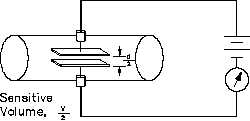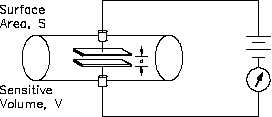IONIZATION CHAMBER
Radiation Detectors
When using an ionization chamber for detecting neutrons, beta particles can be prevented from
entering the chamber by walls thick enough to shield out all of the beta particles. Gamma rays
cannot be shielded from the detector; therefore, they always contribute to the total current read
by the ammeter. This effect is not desired because the detector responds not only to neutrons,
but also to gamma rays. Several ways are available to minimize this problem.
Discrimination is possible because the ionizations produced by the alpha particles differ in energy
levels from those produced by gamma rays. A 1 MeV alpha particle moving through the gas
loses all of its energy in a few centimeters. Therefore, all of the secondary electrons are
produced along a path of only a few centimeters. A 1 MeV gamma ray produces a 1 MeV
electron, and this electron has a long range and loses its energy over the entire length of its
range. If we make the sensitive volume of the chamber smaller without reducing the area of the
coated boron, the sensitivity to gamma rays is reduced.
Figure 17 illustrates how the chamber may be modified to accomplish this reduction.
Figure 17 Minimizing Gamma Influence by Size and Volume
In Figure 17(b) there is half as much gas in the sensitive volume as in the chamber in Figure
17(a). As a result, gamma rays have only half as much gas to interact with; therefore, half the
number of electrons are produced. The area which is boron-coated has not changed, and both
chambers produce the same number of neutron-induced alpha particles. Also, the gamma ray-
induced electrons produce fewer ionizations because the range of these electrons is longer than
the dimensions of the sensitive volume. The range of neutron-induced alpha particles is short,
and all of the energy will be dissipated within the sensitive volume, even when the volume is
smaller.
IC-06
Page 32
Rev. 0



